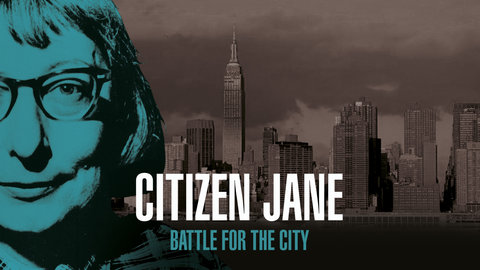The epic struggles between Jane Jacobs and Robert Moses have achieved mythic status in the lore of urban planners: two larger-than-life heroes battling over the streets, skylines, and neighborhoods of New York City. Given the importance of this story (and the recent market for superhero films), the appearance of the two together on the silver screen seems long overdue.
CITIZEN JANE: BATTLE FOR THE CITY (Hammond/Tyrnauer, 2017) fills this gap: a workmanlike treatment of the topic, with just enough background and gloss for the newbie, yet plenty of surprising details and war stories to keep the attention of the old hand.
The viewpoint is certainly not “balanced” – Jacobs gets top billing, and seems to have resoundingly won this debate, at least for the present — but the treatment is nonetheless fair, with enough historical context to help viewers appreciate the fears of urban decay that Moses was confronting and the Utopian visions his modernist projects were trying to embrace.
The film is rife with talking heads – over a dozen planners, academics, politicians, activists, and historians, including Max Page, James Howard Kunstler, Mary Rowe, Anthony Flint, Thomas Campanella, and even Mayor Ed Koch – but it wisely limits each to short quips and color commentary. The voices of actors Marisa Tomei and Vincent D’Onofrio bring the words of Jacobs and Moses to life as well.
Primarily, the story is allowed to unfold through an impressive array of archival material: footage of both vibrant streets and failing slums; maps, plans, and renderings depicting gleaming urban renewal schemes (often matched with disappointing images of the post-construction reality); newsreels of “experts” – male, white, suited – planner-splaining their remedies for the cancer of inner city blight; and the obligatory shots of the wrecking ball and the imploding tenement.
The story takes a few side-treks along the way, situating Jacobs in a decade of protest (feminist, environmental, civil rights, anti-war, and highway revolt movements) and exploring the rise and abandonment of large-scale public housing projects. The introductory scenes and closing chapter remind us that the story is not just about New York in the 1950s: urbanization continues to accelerate, and the future of the planet may hinge on the lessons we learn or ignore from this pivotal past.
Viewers eager for more might also be interested in checking out “City Limits,” a 1971 documentary by Laurence Hyde featuring interviews with Jacobs with some great footage from the era; see https://www.nfb.ca/film/city_limits/ to watch online.
(An edited version of this review appeared in the July 2017 issue of Planning Magazine.)
